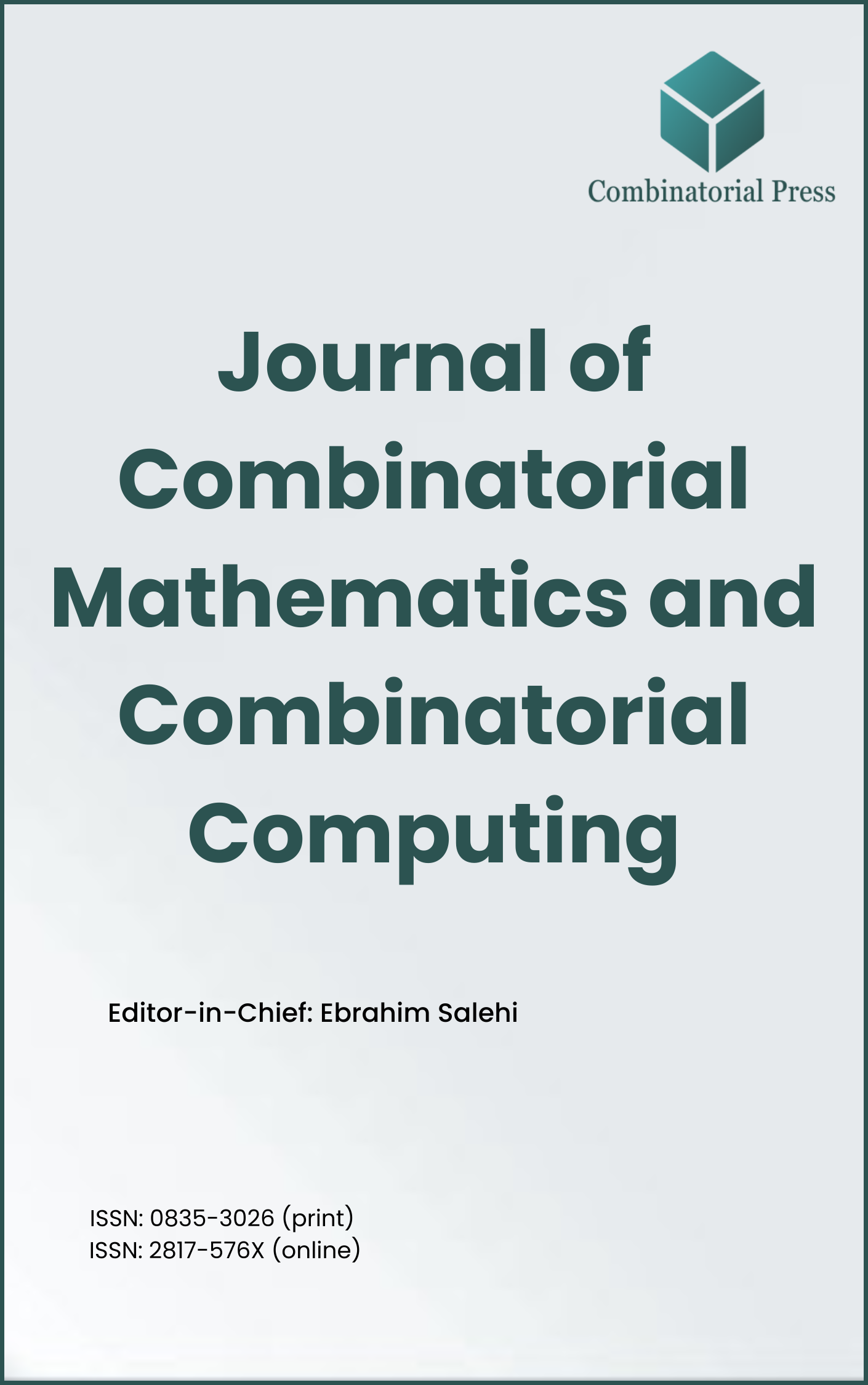
Journal of Combinatorial Mathematics and Combinatorial Computing
ISSN: 0835-3026 (print) 2817-576X (online)
The Journal of Combinatorial Mathematics and Combinatorial Computing (JCMCC) embarked on its publishing journey in April 1987. From 2024 onward, it publishes four volumes per year in March, June, September and December. JCMCC has gained recognition and visibility in the academic community and is indexed in renowned databases such as MathSciNet, Zentralblatt, Engineering Village and Scopus. The scope of the journal includes; Combinatorial Mathematics, Combinatorial Computing, Artificial Intelligence and applications of Artificial Intelligence in various files.
- Research article
- https://www.doi.org/10.61091/jcmcc125-11
- Full Text
- Journal of Combinatorial Mathematics and Combinatorial Computing
- Volume 125
- Pages: 151-163
- Published Online: 27/03/2025
For a graph \(F\) and a positive integer \(t\), the edge-disjoint Ramsey number \(ER_t(F)\) is the minimum positive integer \(n\) such that every red-blue coloring of the edges of the complete graph \(K_n\) of order \(n\) results in \(t\) pairwise edge-disjoint monochromatic copies of a subgraph isomorphic to \(F\). Since \(ER_1(F)\) is in fact the Ramsey number of \(F\), this concept extends the standard concept of Ramsey number. We investigate the edge-disjoint Ramsey numbers \(ER_t(K_{1, n})\) of the stars \(K_{1, n}\) of size \(n\). Formulas are established for \(ER_t(K_{1, n})\) for all positive integers \(n\) and \(t = 2, 3, 4\) and bounds are presented for \(ER_t(K_{1, n})\) for all positive integers \(n\) and \(t \ge 5\). Furthermore, exact values of \(ER_t(K_{1, n})\) are determined for \(n = 3, 4\) and several integers \(t \ge 5\).
- Research article
- https://www.doi.org/10.61091/jcmcc125-10
- Full Text
- Journal of Combinatorial Mathematics and Combinatorial Computing
- Volume 125
- Pages: 135-149
- Published Online: 27/03/2025
The development of artificial intelligence enables computers to not only simulate human artistic creations, but also synthesize fine art works with deeper meanings based on natural images. This study digitally parses the fusion of fine art and philosophy visual expressions, and develops a visual expression system based on the fusion of fine art and philosophy by utilizing a variety of key big data algorithms for visual expressions such as adversarial networks. Research on pattern recognition of this system in art creation is carried out through model training, recommendation performance evaluation, pattern recognition strategy application and regression analysis. The model in this paper works best when the number of nearest neighbors k=15, and the recommendation model in this paper can provide a personalized list of artwork recommendations for different people. The recognition of the system in this paper in the five dimensions of “spiritual level”, “value level”, “philosophical level”, “aesthetic level” and “technical level” is distributed between 4.24\(\mathrm{\sim}\)4.55. The results of regression analysis indicated that the system in this paper can improve the artistic creation as well as pattern recognition.
- Research article
- https://www.doi.org/10.61091/jcmcc125-09
- Full Text
- Journal of Combinatorial Mathematics and Combinatorial Computing
- Volume 125
- Pages: 123-133
- Published Online: 27/03/2025
With development of Internet of Things, big data and artificial intelligence, cell phone signaling data, point-of-interest data and machine learning methods have been widely used in research of various fields of transportation. The use of big data processing techniques and machine learning methods to mine intercity travel data collected by various types of traffic detectors provides a new way of thinking to study travel mode selection behavior. In this paper, we pre-processed cell phone signaling data, geospatial data and interest point data around three aspects: personal attributes, travel attributes and travel mode attributes, and designed intercity travel target group extraction, travel chain extraction, travel mode extraction and travel purpose extraction algorithms, which provide basis for travel feature analysis and travel mode choice behavior prediction modeling.
- Research article
- https://doi.org/10.61091/jcmcc125-08
- Full Text
- Journal of Combinatorial Mathematics and Combinatorial Computing
- Volume 125
- Pages: 109-121
- Published Online: 27/03/2025
Conventional techniques to electric power network (EPN) design and management are insufficient to handle extreme weather events like hurricanes due to the growing complexity and fragility of power systems. As a sophisticated simulation and optimization tool, digital twin (DT) technology may offer real-time power infrastructure monitoring and prediction. This study aims to investigate the possible application of digital twin technology in enhancing power system resilience and streamlining the design process, as well as to use it for the 3D design of the full substation engineering infrastructure process. A digital twin-based EPN model that incorporates all of the main components of the power system—power plants, substations, transmission and distribution networks, and customers—is proposed in this paper. Every component of the power system undergoes vulnerability analysis, and the chance of the system failing is calculated using a Bayesian network (BN) model and a parametric vulnerability function. According to modeling projections, Hurricane Ike will cause the majority of consumers’ power supplies to be interrupted. The model predicts that power consumption for residential, commercial, and industrial buildings will be 96.4%, 96.0%, and 94.2%, respectively, depending on the kind of building.
- Research article
- https://www.doi.org/10.61091/jcmcc125-07
- Full Text
- Journal of Combinatorial Mathematics and Combinatorial Computing
- Volume 125
- Pages: 93-107
- Published Online: 27/03/2025
Radar ranging and speed measurement are common applications in daily life, with performance largely dependent on the radar signal processor. However, existing civilian radar signal processors struggle with weak signal reception and low analysis efficiency. This study designs a high-speed radar signal processor based on FPGA architecture, incorporating a fusion processing algorithm to integrate different radar signal bands, enhancing processing efficiency and accuracy. The design includes data feature analysis, storage, and fusion modules. Tests showed that the processor achieved real-time performance with a processing time under 1ms, a ranging error below 1m, and speed measurement accuracy within 5m/s, meeting practical requirements.
- Research article
- https://doi.org/10.61091/jcmcc125-06
- Full Text
- Journal of Combinatorial Mathematics and Combinatorial Computing
- Volume 125
- Pages: 79-91
- Published Online: 27/03/2025
Intriguing symmetries are uncovered regarding all magic squares of orders 3, 4, and 5, with 1, 880, and 275,305,224 distinct configurations, respectively. In analogy with the travelling salesman problem, the distributions of the total topological distances of the paths travelled by passing through all the vertices (matrix elements) only once and spanning all elements of the matrix are analyzed. Symmetries are found to characterise the distributions of the total topological distances in these instances. These results raise open questions about the symmetries found in higher-order magic squares and the formulation of their minimum and maximum total path lengths.
- Research article
- https://www.doi.org/10.61091/jcmcc125-05
- Full Text
- Journal of Combinatorial Mathematics and Combinatorial Computing
- Volume 125
- Pages: 69-78
- Published Online: 27/03/2025
In this paper, we introduce the concept of vertex-edge locating Roman dominating functions in graphs. A vertex-edge locating Roman dominating \({(ve-LRD)}\) function of a graph \(G=(V,E)\) is a function \(f:V(G)\rightarrow\{0,1,2\}\) such that the following conditions are satisfied: (i) for every adjacent vertices \(u,v\) with \(f(u)=0\) or \(f(v)=0\), there exists a vertex \(w\) at distance \(1\) or \(2\) from \(u\) or \(v\) with \(f(w)=2\), (ii) for every edge \(uv\in E\), \(\max[f(u),f(v)]\neq 0\), and (iii) any pair of distinct vertices \(u,v\) with \(f(u)=f(v)=0\) does not have a common neighbour \(w\) with \(f(w)=2\). The weight of ve-LRD function is the sum of its function values over all the vertices. The vertex-edge locating Roman domination number of \(G\), denoted by \(\gamma_{veLR}(G)\), is the minimum weight of a {ve-LRD} function in \(G\). We proved that the vertex-edge locating Roman domination problem is NP-complete for bipartite graphs. Also, we present the upper and lower bounds of \({ve-LRD}\) function for trees. Lastly, we give the upper bounds of \({ve-LRD}\) function for some connected graphs.
- Research article
- https://doi.org/10.61091/jcmcc125-04
- Full Text
- Journal of Combinatorial Mathematics and Combinatorial Computing
- Volume 125
- Pages: 55-68
- Published Online: 27/03/2025
Traditional personnel recruitment methods are often inefficient and struggle to find candidates who meet job requirements. In this paper, we first develop a comprehensive personnel management system for colleges and universities that streamlines the recruitment process and information management. Next, recruitment data from the system is analyzed using the fuzzy C-means algorithm to cluster applicant profiles and extract position-specific user characteristics. Finally, a joint embedded neural network is employed to match applicant profiles with job positions by optimizing an objective function. Experimental results demonstrate a high job matching rate (up to 98.1%), a significantly reduced recruitment cycle (from job posting to candidate onboarding in 25 days), and a system response time as low as 0.5 seconds. These findings highlight the effectiveness of big data technology in providing timely feedback, reducing recruitment costs and staff workload, and promoting the intelligent development of talent recruitment.
- Research article
- https://www.doi.org/10.61091/jcmcc125-03
- Full Text
- Journal of Combinatorial Mathematics and Combinatorial Computing
- Volume 125
- Pages: 39-53
- Published Online: 27/03/2025
The rapid development of information technology makes intelligent decision support system play an increasingly important role in economic standardized management. The Intelligent Decision Support System (IDSS) constructed in this paper includes interaction layer, analysis layer and data layer. The system standardizes the management of enterprise economy through strategic forecasting and decision analysis, economic planning and control, and economic analysis. The study combines the fuzzy hierarchical analysis method (FAHP) and the fuzzy comprehensive evaluation method (FCE) to evaluate the standardized level of economic management of enterprise A. The evaluation score of the standardized level of enterprise A’s economic management is \(F=80.955\), which is greater than 80, and it belongs to the grade of “good”. It shows that the intelligent decision support system constructed based on this paper can effectively help standardize the management of enterprise economy.
- Research article
- https://www.doi.org/10.61091/jcmcc125-02
- Full Text
- Journal of Combinatorial Mathematics and Combinatorial Computing
- Volume 125
- Pages: 21-38
- Published Online: 27/03/2025
In order to solve the multi-objective optimization problem of resource allocation in enterprise strategic management, the article firstly establishes a multi-objective resource allocation model for maximizing the benefits of enterprises in enterprise strategic management. Then, it optimizes and improves the initial population, convergence factor and dynamic weights of the gray wolf algorithm, increases the population diversity by using the population strategy of reverse learning, improves the convergence factor into a nonlinear factor, and finally changes the decision-making weights of the gray wolf leadership and applies the dynamic weights to improve the accuracy of the algorithm. Subsequently, the improved gray wolf algorithm is utilized for model decoupling. By applying this paper’s algorithm and the other two algorithms to solve the six algorithms 30*6, 60*6, 90*2, 90*4, 150*4 and 150*6 for 9 times, it is found that in the analysis of the 30*6 algorithm, the enterprise’s resource allocation reaches 5,000 when the time is 110 s. At the same time, this paper’s algorithm obtains a better non-dominated solution than the other two algorithms, which proves that this paper’s algorithm solves the multi-objective resource allocation problem of enterprise law industry is proved to be effective.





